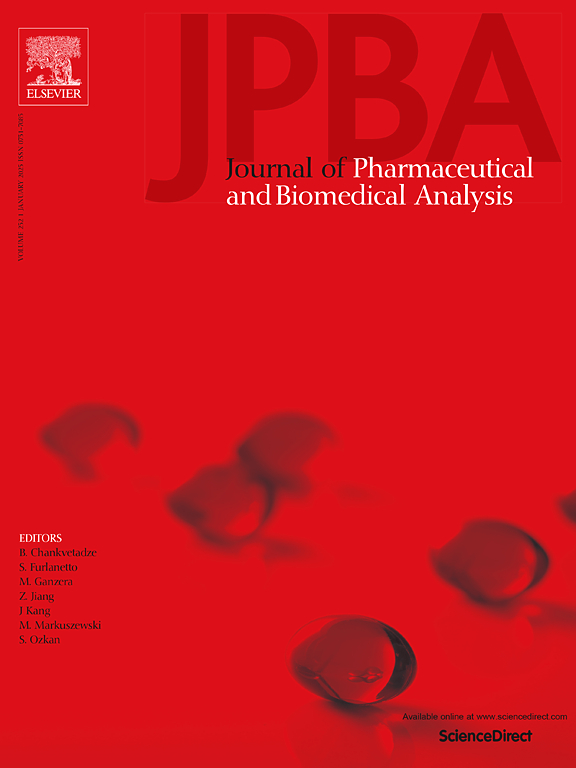Non-invasive therapeutic drug monitoring: LC-MS validation for lamotrigine quantification in dried blood spot and oral fluid/saliva
IF 3.1
3区 医学
Q2 CHEMISTRY, ANALYTICAL
Journal of pharmaceutical and biomedical analysis
Pub Date : 2025-04-11
DOI:10.1016/j.jpba.2025.116877
引用次数: 0
Abstract
Epilepsy, affecting over 50 million people globally, presents a significant neurological challenge. Effective prevention of epileptic seizures relies on proper administration and monitoring of Anti-Seizure Medication (ASMs). Therapeutic Drug Monitoring (TDM) ensures optimal dosage adjustment, minimizing adverse effects and potential drug interactions. While traditional venous blood collection for TDM may be stressful, emerging alternative sampling methods, particularly Dried Blood Spot (DBS) or oral fluid offer less invasive way of sampling. This study aimed to develop and validate an analytical method for the determination of lamotrigine in such alternative samples. The sample, either DBS or oral fluid, was subjected to extraction, evaporation, and reconstitution in 15 % acetonitrile containing 0.1 % formic acid. A Kinetex C18 Polar column was used for liquid chromatographic separation and MS in ESI+ mode was used for detection and quantitation of lamotrigine using an isotopically labelled internal standard according to EMA guidelines. The calibration range of the developed method enables the determination of lamotrigine in the concentration range of 1–30 μg/mL in DBS and 0.5–20 μg/mL in oral fluid. Oral fluid and DBS samples from patients treated with lamotrigine analysed by the developed method were compared to plasma concentrations measured by the hospital's accredited laboratory. Preliminary results indicate a promising potential for these alternative matrices in clinical TDM applications. By offering a less invasive sampling approach, this method improves the accessibility and safety of pharmacotherapy for epilepsy patients. The results of this study lay the foundation for further clinical applications by implementing alternative matrix TDM, which may significantly advance personalized care in epilepsy management.
无创治疗药物监测:干血斑和口服液/唾液中拉莫三嗪定量的LC-MS验证
癫痫影响着全球5000多万人,对神经系统构成重大挑战。有效预防癫痫发作依赖于抗癫痫药物(asm)的适当管理和监测。治疗药物监测(TDM)确保最佳剂量调整,最大限度地减少不良反应和潜在的药物相互作用。虽然传统的TDM静脉血采集可能会有压力,但新兴的替代采样方法,特别是干血点(DBS)或口腔液体提供了侵入性较小的采样方法。本研究旨在建立和验证一种分析方法,以确定拉莫三嗪在这些替代样品。样品(DBS或口服液)在含有0.1 %甲酸的15 %乙腈中进行提取、蒸发和重构。采用Kinetex C18极性色谱柱进行液相色谱分离,采用ESI+ 模式的质谱法根据EMA指南使用同位素标记的内标进行拉莫三嗪的检测和定量。所建立的方法的校准范围能够测定拉莫三嗪在DBS中浓度范围为1 ~ 30 μg/mL,在口服液中浓度范围为0.5 ~ 20 μg/mL。采用该方法分析的接受拉莫三嗪治疗的患者的口服液和DBS样本与医院认可实验室测量的血浆浓度进行了比较。初步结果表明,这些替代基质在临床TDM应用中具有很大的潜力。通过提供一种侵入性较小的采样方法,该方法提高了癫痫患者药物治疗的可及性和安全性。本研究结果为进一步实施替代基质TDM的临床应用奠定了基础,可能会显著推进癫痫治疗的个性化护理。
本文章由计算机程序翻译,如有差异,请以英文原文为准。
求助全文
约1分钟内获得全文
求助全文
来源期刊
CiteScore
6.70
自引率
5.90%
发文量
588
审稿时长
37 days
期刊介绍:
This journal is an international medium directed towards the needs of academic, clinical, government and industrial analysis by publishing original research reports and critical reviews on pharmaceutical and biomedical analysis. It covers the interdisciplinary aspects of analysis in the pharmaceutical, biomedical and clinical sciences, including developments in analytical methodology, instrumentation, computation and interpretation. Submissions on novel applications focusing on drug purity and stability studies, pharmacokinetics, therapeutic monitoring, metabolic profiling; drug-related aspects of analytical biochemistry and forensic toxicology; quality assurance in the pharmaceutical industry are also welcome.
Studies from areas of well established and poorly selective methods, such as UV-VIS spectrophotometry (including derivative and multi-wavelength measurements), basic electroanalytical (potentiometric, polarographic and voltammetric) methods, fluorimetry, flow-injection analysis, etc. are accepted for publication in exceptional cases only, if a unique and substantial advantage over presently known systems is demonstrated. The same applies to the assay of simple drug formulations by any kind of methods and the determination of drugs in biological samples based merely on spiked samples. Drug purity/stability studies should contain information on the structure elucidation of the impurities/degradants.

 求助内容:
求助内容: 应助结果提醒方式:
应助结果提醒方式:


